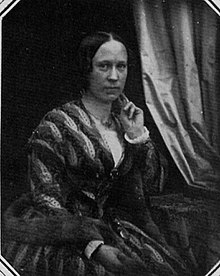Bertha Wehnert-Beckmann
Bertha Wehnert-Beckmann (born January 25, 1815 in Cottbus , † December 6, 1901 in Leipzig ) was a German photographer. In 1842 she was the first professional photographer in Germany to open her own photo studio.
Life
Bertha Beckmann was born in Cottbus in 1815; her father was a master tailor. Between 1839 and 1843 she lived in Dresden . According to the latest findings, she daguerreotyped in the autumn of 1842 in Prague with Wilhelm Horn . She had probably taught herself the new technique beforehand. At the beginning of December 1842 she was the first professional photographer in Europe to offer her services in Dresden, after which she went on tour as a wandering daguerreotypist. She also earned additional income with homemade craftsmanship, such as flower arrangements made of spices and wax.
At the end of 1845 she married the Leipzig daguerreotypist Eduard Wehnert (1811–1847), with whom she had previously opened a joint photo studio on Burgstrasse in Leipzig. Her husband passed away two years later and she continued the business with the support of her two brothers and later other assistants.
In 1849 she took a trip to New York , where she set up a small studio on Broadway. She received US political figures, including President Millard Fillmore , Senator Henry Clay and Senator Sam Houston ; but also artists and musicians like Jenny Lind and their entourage. The American Institute awarded her a "Diploma for Special Services to Portrait Photography" in 1850 and a silver medal in 1851.
Previously unknown was her pioneering role in the field of paper photography in the USA and which was presented in detail in the book "A German Lady". The found calotypes from the years 1850/51, which were made in New York, can be described as sensational. After her return in autumn 1851, she developed her business in Leipzig into the most important studio in the city. In 1854 she opened the first stereoscope exhibition in the German-speaking area in Leipzig. Until 1860 she was the only woman taking photos in the world who took nude photos.
In 1866 she had a new studio and a villa built on her property on Elstermühlgraben at Elsterstrasse 38. The villa has been preserved, the studio was converted into residential use as early as 1883, but its shape can still be recognized. Bertha Wehnert-Beckmann did not retire until 1882.
Wehnert-Beckmann is the first professional photographer in the world who can prove a photographic oeuvre. Over 4000 portrait photographs ( daguerreotypes , calotypes , collodion negatives ) are known to date.
literature
- Jochen Voigt, Christoph Kaufmann: The frozen moment. Daguerreotype in Saxony 1839–1860. Edition Mobilis, Chemnitz 2004, ISBN 3-9808878-2-0 .
- Jochen Voigt: A German Lady. Bertha Wehnert-Beckmann. Life and work of a photography pioneer. Edition Mobilis, Chemnitz 2014, ISBN 978-3-9813691-2-0 .
- Volker Rodekamp (ed.): The photographer. Bertha Wehnert-Beckmann 1815–1901. (Book accompanying the exhibition at the Leipzig City History Museum , January 25 - April 26, 2015), Passage-Verlag, Leipzig 2014, ISBN 978-3-95415-031-1 .
- Acquisitions. Photo fever. In: Arsprototo - Das Magazin der Kulturstiftung der Länder , ISSN 1860-3327 , H. 1/2015, p. 16.
- Wehnert-Beckmann, Bertha, b. Beckmann In: Nicole Schönherr: Street names in Dresden - a man's business? (PDF; 219 kB) State capital Dresden. The Lord Mayor, Equal Opportunities Officer for women and men, Dresden 2005, p. 32.
Web links
- Directory of collections with photographs by Bertha Wehnert-Beckmann at fotoerbe.de
- City of Leipzig, Department for Youth, Family and Social Affairs: Biographies of historical women personalities: Photography, Bertha Ernestine Henriette Wehnert-Beckmann, b. Beckmann ( Memento from June 1, 2016 in the Internet Archive ).
Remarks
- ↑ This role is challenged by the brothers Wilhelm Langenheim (1807–1874) and Friedrich Langenheim (1809–1879) from Braunschweig, who daguerreotyped in Philadelphia since the early 1940s and had sought a license from Fox Talbot in 1849. (See the mentions in: Carl August Theodor Ehrmann. In: Photographische Rundschau , 1892, p. 218 f. The “Frau Wehna” mentioned there refers to Bertha Wehnert-Beckmann.) See also a short necrology on William Langenheim in Editors Table . In: Philadelphia Photographer , Benerman & Wilson, Philadelphia June 1874, pp. 190-191, digitized .
| personal data | |
|---|---|
| SURNAME | Wehnert-Beckmann, Bertha |
| BRIEF DESCRIPTION | German photographer |
| DATE OF BIRTH | January 25, 1815 |
| PLACE OF BIRTH | cottbus |
| DATE OF DEATH | December 6, 1901 |
| Place of death | Leipzig |

